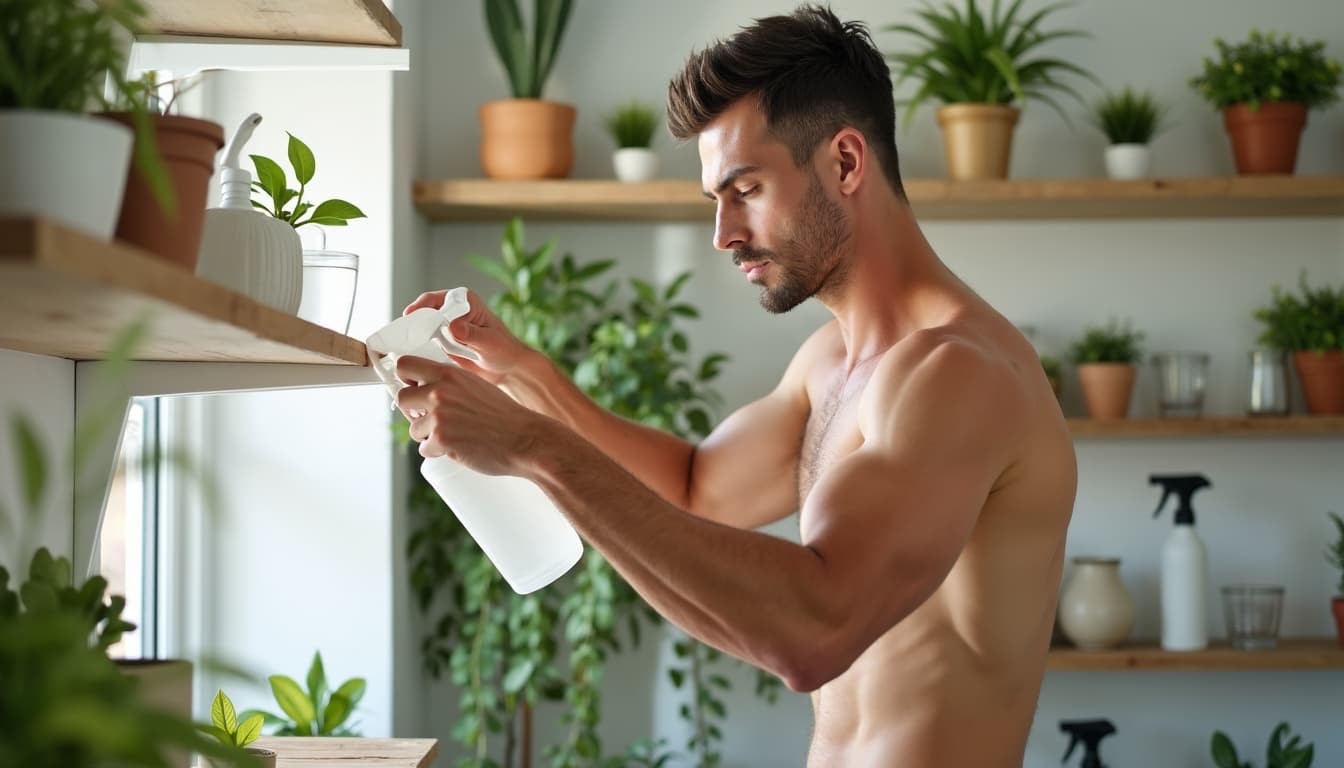The Unseen Threat: Reclaiming Your Home from Hidden Chemicals

Your meticulously optimized living space harbors an insidious, often ignored, danger: pervasive household chemicals silently compromising your health and sanctuary. From everyday cleaners to air fresheners, these compounds inflict measurable biological harm, turning your supposed haven into a low-level exposure zone. It's time to decode misleading labels, strategically purge toxic products, and upgrade your environment to reclaim your home as a foundation for peak performance and profound well-being.
You've meticulously optimized your living space for comfort and aesthetics—an intentional sanctuary. But beneath the polished surfaces and curated décor lies a significant, often ignored, threat: household chemicals. These aren't obscure industrial pollutants; they are pervasive compounds in everyday products, actively compromising your health and the integrity of your living environment. This isn't about vague "vibes"; it's about measurable biological impact. Your home should be a foundation for peak performance and recovery, not a low-level chemical exposure zone. Understanding these unseen influences is non-negotiable for anyone serious about true environmental control and personal well-being.
The Chemical Burden: Deconstructing Common Household Toxins
The promise of "pristine cleanliness" often comes at a steep cost to indoor air quality and personal health. Many conventional products introduce a cocktail of hazardous compounds. Here’s a breakdown of the primary offenders:
All-Purpose Cleaners & Disinfectants:
- Ammonia: A direct respiratory irritant. Crucially, never mix with bleach; the resulting chloramines are highly toxic, causing severe lung damage.
- Chlorine Bleach (Sodium Hypochlorite): A powerful disinfectant, but it off-gasses Volatile Organic Compounds (VOCs) and is corrosive. Chronic exposure can exacerbate asthma and irritate mucosal membranes. (Reference: Environmental Health Perspectives, 2013).
- Quaternary Ammonium Compounds (Quats): Often found in "antibacterial" cleaners, quats are potent irritants, known allergens, and have been linked to occupational asthma. (Reference: American Journal of Respiratory and Critical Care Medicine, 2014).
Laundry & Fabric Care:
The "fresh" scent often disguises a chemical load.
- Synthetic Fragrances: A proprietary blend on labels, often containing hundreds of undisclosed chemicals. Many are known allergens, respiratory irritants, and endocrine disruptors. They trigger headaches, asthma attacks, and skin sensitivities. (Reference: Air Quality, Atmosphere & Health, 2019).
- Phthalates: Used to extend fragrance longevity, these are potent endocrine disruptors linked to hormonal imbalances and reproductive issues. (Reference: Environmental Health Sciences, 2015).
- Optical Brighteners: Fluorescent dyes that make fabrics appear whiter. Non-biodegradable and potential skin irritants.
Air Fresheners & Scented Products:
Designed to mask, they add pollutants.
- VOCs (Volatile Organic Compounds): Products like plug-ins and scented candles release formaldehyde (a known human carcinogen, IARC) and benzene (a carcinogen and immune suppressant). These contribute significantly to indoor air pollution.
- Artificial Fragrances & Phthalates: As noted, these are ubiquitous and contribute to both air quality degradation and systemic health risks. Even new furniture can off-gas formaldehyde for years.
The scientific literature is unequivocal: an uncritical approach to cleaning products introduces measurable health hazards. True environmental mastery demands knowing what you're bringing into your home.
Deciphering the Deception: Navigating Labels and Greenwashing

The marketing landscape of household products is riddled with misleading claims. Terms like "natural," "green," and "non-toxic" are largely unregulated and often designed to obscure harmful ingredients. "Natural" doesn't equate to safe. "Non-toxic" typically refers to acute, immediate harm, ignoring chronic exposure risks. "Hypoallergenic" simply means fewer common allergens, not an allergen-free guarantee. This is deliberate "greenwashing."
To make informed decisions, you must become fluent in ingredient lists:
- "Fragrance" / "Parfum": This catch-all term often conceals phthalates and hundreds of other undisclosed chemicals. Consider it a red flag.
- Phthalates: Explicitly listed or hidden in "fragrance." Disrupt endocrine function.
- Parabens (Methylparaben, Propylparaben): Common preservatives, also endocrine disruptors.
- VOCs: Look for explicit "low VOC" or "no VOC" claims, particularly in paints, adhesives, and air fresheners.
- Sulfates (SLS, SLES): Skin irritants common in lathering products.
For verification, rely on reputable third-party certifications:
- EPA Safer Choice: Identifies products with safer chemical ingredients.
- EWG Verified: Ensures strict health standards and full ingredient transparency.
Don't fall for marketing rhetoric. Your health depends on critical label literacy.
Strategic De-load & Upgrade: Rebuilding Your Home's Health Infrastructure

Optimizing your home demands a calculated purge and a mindful re-investment in effective, non-toxic alternatives.
Kitchen & Bathroom Protocol:
- Purge: Ammonia-based cleaners, bleach, synthetic-fragranced detergents.
Enjoying this content? Support our work by taking a moment to visit the sponsor of this article
Visit Sponsor- Upgrade: Plant-based cleaners using surfactants, enzymes, and essential oils (lemon, tea tree). For disinfection, hydrogen peroxide or thymol are superior to bleach. Use phosphate-free, dye-free dish soaps, ideally with concentrated refill options to minimize waste.
Laundry Room Optimization:
- Purge: Conventional detergents with sulfates, optical brighteners, and synthetic perfumes. Fabric softeners and dryer sheets.
- Upgrade: Unscented, plant-based detergents with natural enzymes. White vinegar in the rinse cycle effectively softens fabrics. Use wool dryer balls to reduce drying time and static; add pure essential oils for natural fragrance.
Indoor Air Quality Management:
- Purge: Air fresheners, plug-ins, synthetic scented candles.
- Upgrade: Prioritize ventilation. Open windows daily for cross-ventilation. Use pure essential oil diffusers for scent. Opt for soy or beeswax candles with essential oils, not synthetic fragrances. Integrate NASA-recommended air-purifying plants (e.g., Snake Plant, Peace Lily, Boston Fern).
These aren't merely "eco-friendly" choices; they are performance enhancements for your living environment, directly translating to reduced chemical exposure and improved physiological well-being.
The DIY Master: Crafting Your Own High-Performance Solutions
For maximum control and cost-efficiency, mastering DIY cleaning solutions is essential. This is about leveraging fundamental chemistry for superior results.
All-Purpose Vinegar Spray:
- Science: White vinegar (acetic acid) is a natural degreaser, mineral solvent, and mild disinfectant.
- Recipe: Equal parts distilled white vinegar and water in a spray bottle.
- Enhancement: Add 10-20 drops of lemon (degreasing) or tea tree (antimicrobial) essential oil. Avoid on natural stone.
Baking Soda Heavy-Duty Scrub:
- Science: Baking soda (sodium bicarbonate) is a mild abrasive and odor neutralizer.
- Recipe: Mix baking soda with enough water or liquid castile soap to form a paste.
- Application: Apply to sinks, tubs, or tough grime. Let sit briefly, then scrub and rinse.
Natural Linen & Room Refresher:
- Science: Witch hazel helps essential oils disperse in water.
- Recipe: Distilled water, 1 tbsp witch hazel, 15-20 drops pure essential oils (e.g., eucalyptus for invigorating, lavender for calming).
- Application: Fine-mist spray on fabrics, upholstery, or as a room freshener.
These simple, scientifically sound recipes empower you to eliminate chemical unknowns from your cleaning regimen.
Holistic Toxicity Reduction: Protecting All Inhabitants
Personal Care Products:
- Issue: Many body washes, shampoos, and grooming products contain sulfates, parabens, and hidden phthalates. These absorb systemically.
- Solution: Demand "sulfate-free," "paraben-free," and "phthalate-free" products. Opt for ingredient transparency and natural scent sources (essential oils). This is direct protection for your body's largest organ: your skin.
Pet & Plant Health:
- Issue: Pets, due to their size and grooming habits, are highly vulnerable to chemical residues from floor cleaners, carpet treatments, and laundry detergents. Synthetic pesticides are neurotoxins for both animals and humans.
- Solution: Use only pet-safe, plant-based cleaners in pet areas. Avoid phenols, ammonia, and bleach. For plants, ditch neurotoxic pesticides. Employ natural pest control: neem oil (insect growth disruptor) or insecticidal soap. Regularly wipe plant leaves with water.
A truly optimized home considers the chemical load on all its inhabitants.
Sustaining the Optimized Environment: A Strategic Commitment

Maintaining a low-toxicity home is an ongoing strategic commitment, not a one-time cleanse. It reinforces a lifestyle of informed decision-making and environmental mastery.
- Ventilation Discipline: Daily cross-ventilation is paramount. Augment with high-quality MERV 11-13 HVAC filters, regularly maintained.
- Mindful Procurement: Every new item entering your home – from furniture to personal care – must pass a critical chemical assessment. Prioritize transparent ingredient lists, minimal packaging, and robust third-party certifications. Invest in durable, non-toxic goods over disposable ones.
- Secure Storage: Even safe cleaning alternatives require proper storage in original, labeled containers, away from direct sunlight, and out of reach of children and pets. This prevents accidents and maintains efficacy.
The outcome: a measurably healthier, more invigorating living space. Your home becomes an active contributor to your health, supporting peak physiological function and cognitive clarity. This is true optimization.



